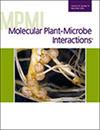Eriko Tanaka, Daisuke Umeki, Shota Kido, Rikako Makishima, Yuko Tamaki, Takumi Murakami, Masayuki Fujiwara, Yusuke Saijo
求助PDF
{"title":"Biocontrol of Bacterial Wilt Disease Using Plant-Associated Bacterial Communities in Tomato.","authors":"Eriko Tanaka, Daisuke Umeki, Shota Kido, Rikako Makishima, Yuko Tamaki, Takumi Murakami, Masayuki Fujiwara, Yusuke Saijo","doi":"10.1094/MPMI-09-24-0114-R","DOIUrl":null,"url":null,"abstract":"<p><p>Host-protective or disease-suppressive microorganisms are emerging as sustainable solutions for controlling crop diseases, such as bacterial wilt. However, the efficacy of biocontrol strategies is often constrained by limited resilience under varying environmental conditions and interactions with native microbial communities in the field. One major challenge is that introduced biocontrol microbes often face suppression by indigenous microbes due to competitive interactions. Synthetic communities (SynComs) offer a promising alternative strategy. However, conventional approaches to assembling SynComs by combining different microbial isolates often result in antagonism and competition among strains, leading to ineffective and inconsistent outcomes. In this study, we assembled a bacterial wilt-suppressive SynCom for tomato, composed of bacterial isolates derived from co-cultured microbial complexes associated with healthy plants. This SynCom demonstrates significant disease-suppressive effects against <i>Ralstonia pseudosolanacearum</i> in tomato seedlings under both axenic and soil conditions. Additionally, our findings suggest the presence of an optimal SynCom colonization level in plants, which is crucial for effective disease suppression. The SynCom also exhibits direct antibiotic activity and modulates the plant-associated microbiome. Our results provide an effective approach to constructing SynComs with consistent and effective disease-suppressive properties within microbial community contexts. [Formula: see text] Copyright © 2025 The Author(s). This is an open access article distributed under the CC BY-NC-ND 4.0 International license.</p>","PeriodicalId":19009,"journal":{"name":"Molecular Plant-microbe Interactions","volume":" ","pages":"411-426"},"PeriodicalIF":3.4000,"publicationDate":"2025-05-01","publicationTypes":"Journal Article","fieldsOfStudy":null,"isOpenAccess":false,"openAccessPdf":"","citationCount":"0","resultStr":null,"platform":"Semanticscholar","paperid":null,"PeriodicalName":"Molecular Plant-microbe Interactions","FirstCategoryId":"99","ListUrlMain":"https://doi.org/10.1094/MPMI-09-24-0114-R","RegionNum":3,"RegionCategory":"生物学","ArticlePicture":[],"TitleCN":null,"AbstractTextCN":null,"PMCID":null,"EPubDate":"2025/5/12 0:00:00","PubModel":"Epub","JCR":"Q2","JCRName":"BIOCHEMISTRY & MOLECULAR BIOLOGY","Score":null,"Total":0}
引用次数: 0
引用
批量引用
Abstract
Host-protective or disease-suppressive microorganisms are emerging as sustainable solutions for controlling crop diseases, such as bacterial wilt. However, the efficacy of biocontrol strategies is often constrained by limited resilience under varying environmental conditions and interactions with native microbial communities in the field. One major challenge is that introduced biocontrol microbes often face suppression by indigenous microbes due to competitive interactions. Synthetic communities (SynComs) offer a promising alternative strategy. However, conventional approaches to assembling SynComs by combining different microbial isolates often result in antagonism and competition among strains, leading to ineffective and inconsistent outcomes. In this study, we assembled a bacterial wilt-suppressive SynCom for tomato, composed of bacterial isolates derived from co-cultured microbial complexes associated with healthy plants. This SynCom demonstrates significant disease-suppressive effects against Ralstonia pseudosolanacearum in tomato seedlings under both axenic and soil conditions. Additionally, our findings suggest the presence of an optimal SynCom colonization level in plants, which is crucial for effective disease suppression. The SynCom also exhibits direct antibiotic activity and modulates the plant-associated microbiome. Our results provide an effective approach to constructing SynComs with consistent and effective disease-suppressive properties within microbial community contexts. [Formula: see text] Copyright © 2025 The Author(s). This is an open access article distributed under the CC BY-NC-ND 4.0 International license.
利用番茄植株相关菌群防治青枯病的研究。
保护宿主或抑制疾病的微生物正在成为控制作物病害(如细菌性枯萎病)的可持续解决方案。然而,生物防治策略的效果往往受到在不同环境条件下有限的恢复力和与现场本地微生物群落的相互作用的限制。一个主要的挑战是引入的生物防治微生物往往面临本地微生物由于竞争相互作用的抑制。合成社区(SynComs)提供了一种很有前途的替代策略。然而,通过组合不同的微生物分离物组装SynComs的传统方法往往会导致菌株之间的拮抗和竞争,从而导致无效和不一致的结果。在这项研究中,我们组装了一个番茄细菌枯萎抑制SynCom,该SynCom由来自与健康植物相关的共培养微生物复合物的细菌分离物组成。在无公害和土壤条件下,该SynCom对番茄青枯病有明显的抑制作用。此外,我们的研究结果表明,植物中存在最佳的SynCom定殖水平,这对有效抑制疾病至关重要。SynCom还表现出直接的抗生素活性,并调节植物相关的微生物组。我们的研究结果为构建在微生物群落环境下具有一致和有效的疾病抑制特性的syncom提供了有效的方法。[公式:见正文]版权所有©2025作者。这是一篇在CC BY-NC-ND 4.0国际许可下发布的开放获取文章。
本文章由计算机程序翻译,如有差异,请以英文原文为准。

 求助内容:
求助内容: 应助结果提醒方式:
应助结果提醒方式:


